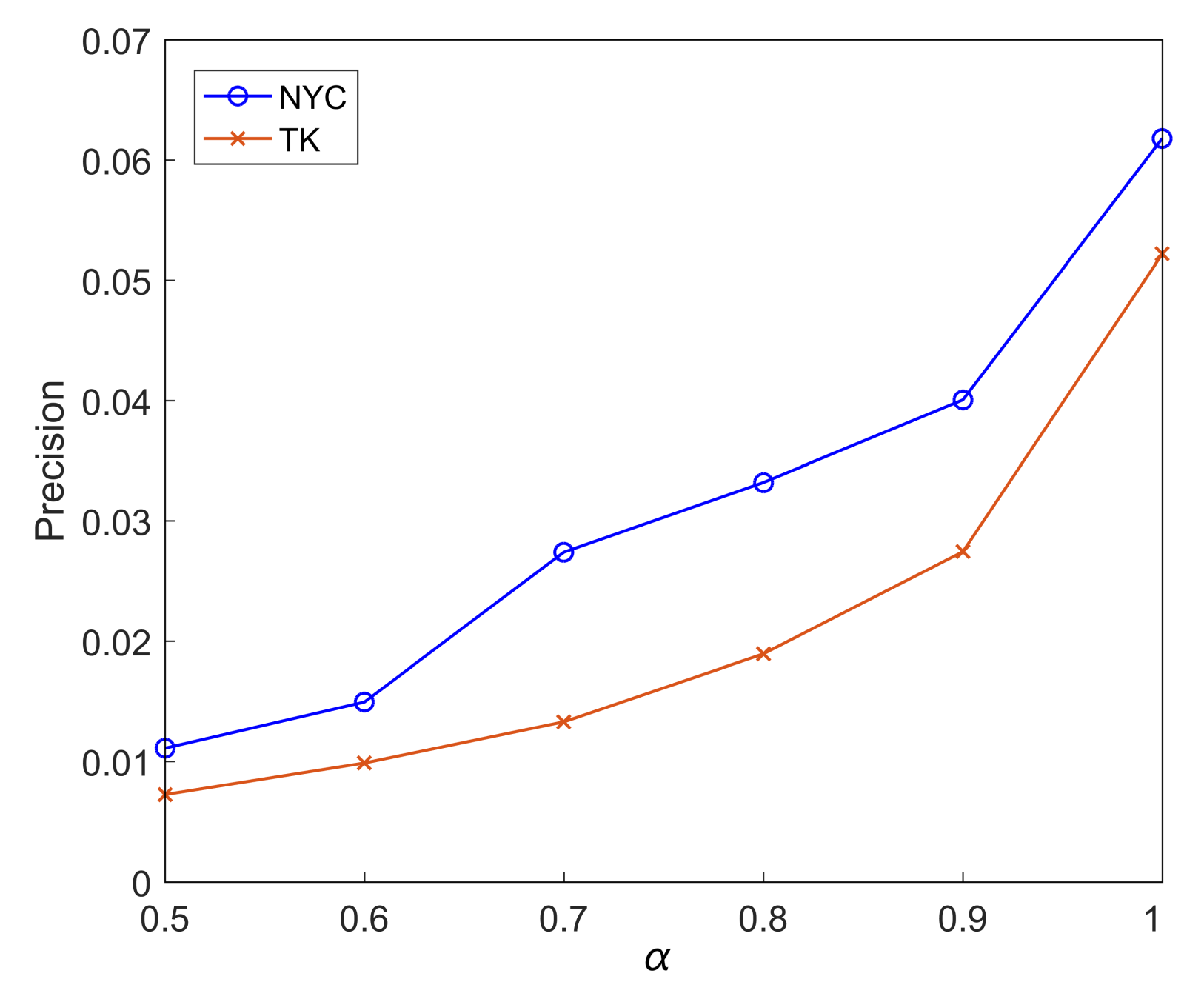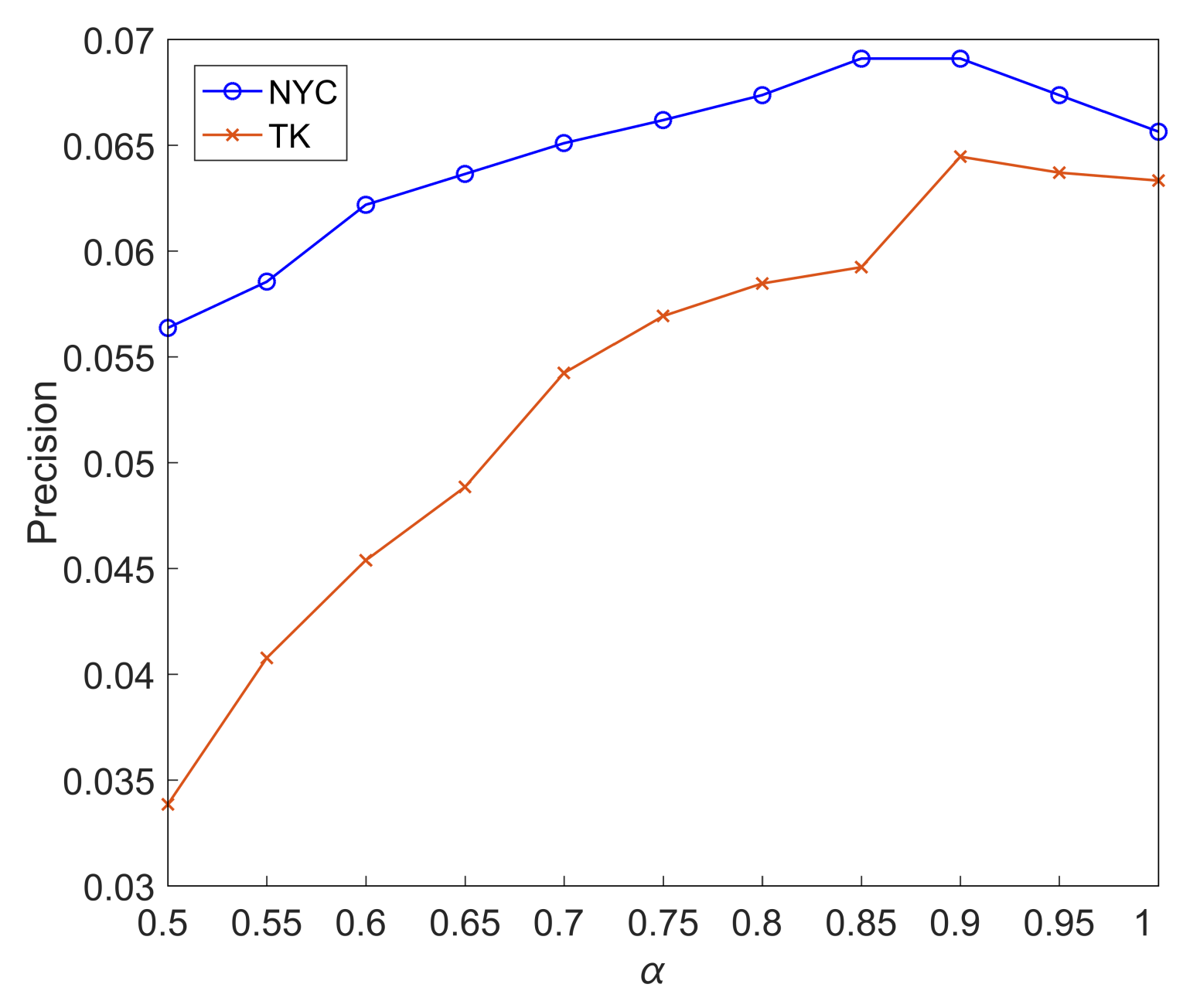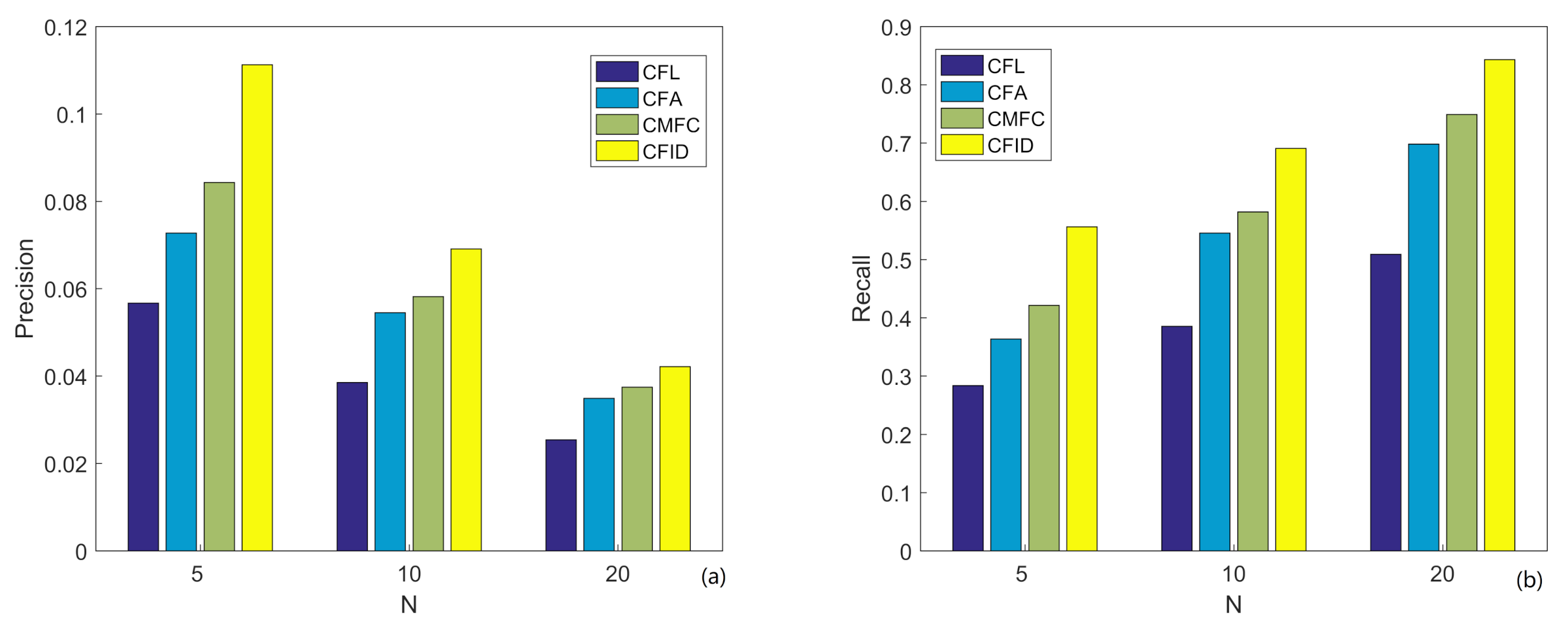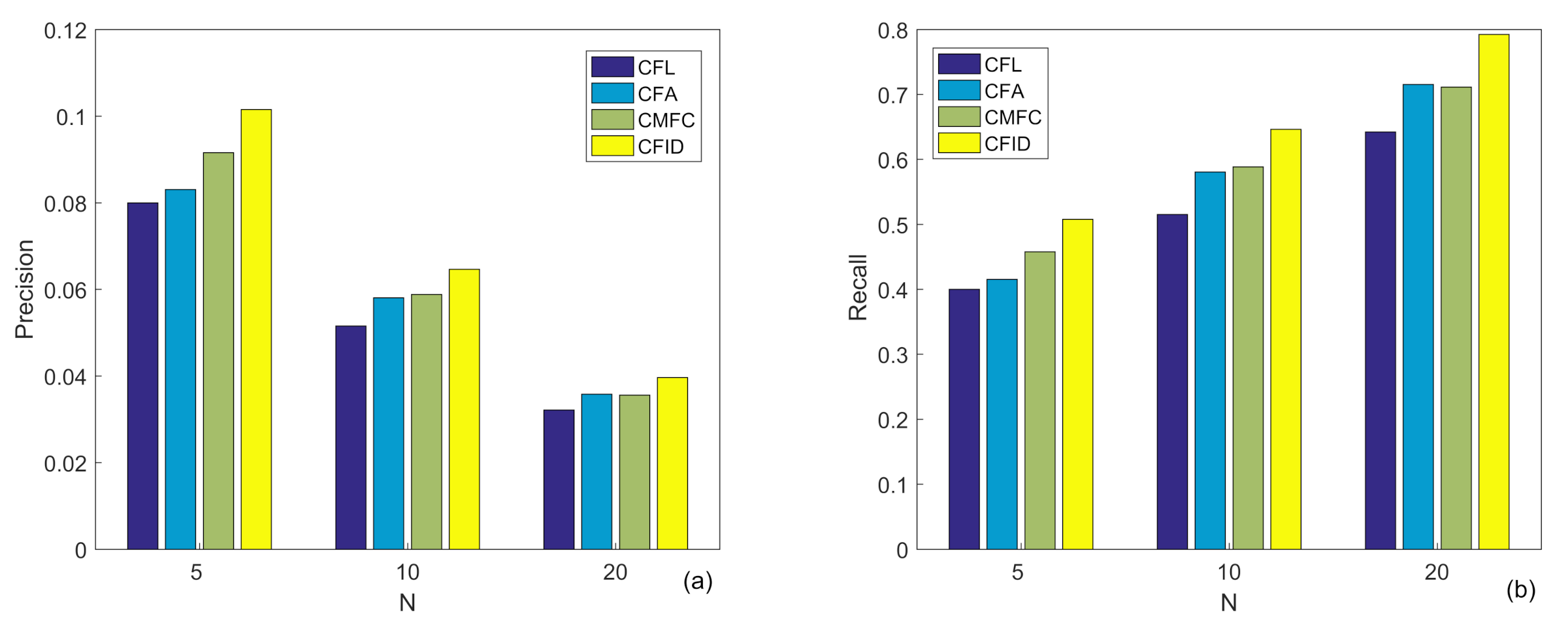A Collaborative Filtering Algorithm with Intragroup Divergence for POI Group Recommendation
Abstract
1. Introduction
2. Related Work
2.1. Aggregate Preference
2.2. Aggregate Recommendation
3. Methodology
3.1. Notation
3.2. Framework of CFID
| Algorithm 1. CFID algorithm. |
|
3.3. User Preference Model Construction
3.4. The Group Preference Model Construction
3.5. POI Group Recommendation Algorithm
4. Experiments and Results Analysis
4.1. Data Set
4.2. Evaluation Metrics
4.3. Comparison of Methods
4.4. Experimental Results
4.4.1. Parameter Setting
4.4.2. POI Group Recommendation Results
5. Conclusions
Author Contributions
Funding
Institutional Review Board Statement
Informed Consent Statement
Data Availability Statement
Conflicts of Interest
References
- Zhao, X.G.; Zhang, Z.; Bi, C.; Sun, Y.J. A new point of interest group recommendation method in location based social networks. Neural Comput. Appl. 2020. [Google Scholar] [CrossRef]
- Xiong, X.; Qiao, S.J.; Han, N.; Xiong, F.; Bu, Z.; Li, R.H.; Yue, K.; Yuan, G. Where to go: An effective point of interest recommendation framework for heterogeneous social networks. Neurocomputing 2020, 373, 56–69. [Google Scholar] [CrossRef]
- Sojahrood, Z.B.; Taleai, M. A POI group recommendation method in location-based social networks based on user influence. Expert Syst. Appl. 2021, 171, 1–13. [Google Scholar]
- Guzzi, F.; Ricci, F.; Burke, R. Interactive multi-party critiquing for group recommendation. In Proceedings of the Conference on Recommender Systems (RecSys’11), Chicago, IL, USA, 23–27 October 2011; ACM Press: New York, NY, USA, 2011; pp. 265–268. [Google Scholar]
- Jameson, A.; Smyth, B. Recommendation to groups. In Adaptive Web; Springer: Berlin, Germany, 2007; pp. 596–627. [Google Scholar]
- Amer-Yahia, S.; Boy, S.B.; Chawlat, A.; Das, G.; Yu, C. Group recommendation: Semantics and efficiency. In Proceedings of the VLDB, Lyon, France, 1 August 2009; Volume 2, pp. 754–765. [Google Scholar]
- Baltrunas, L.; Makcinskas, T.; Ricci, F. Group recommendations with rank aggregation and collaborative filtering. In Proceedings of the 4th ACM Conference on Recommender Systems, Barcelona, Spain, 26–30 September 2010; pp. 119–126. [Google Scholar]
- Zhao, H.; Liu, Q.; Ge, Y.; Kong, R.; Chen, E. Group preference aggregation: A nash equilibrium approach. In Proceedings of the IEEE International Conference on Data Mining, Barcelona, Spain, 12–15 December 2016; pp. 679–688. [Google Scholar]
- Guo, L.; Shao, J.; Tan, K.L.; Yang, Y. Where to go: Personalized travel recommendation for individuals and groups. In Proceedings of the 15th International Conference on Mobile Data Manage, Brisbane, Australia, 14–18 July 2014; pp. 49–58. [Google Scholar]
- Li, C.T.; Huang, M.Y. Team formation with influence maximization for influential event organization on social networks. World Wide Web 2018, 21, 939–959. [Google Scholar] [CrossRef]
- Zhang, J.S.; Gartrell, M.; Han, R.; Lv, Q. GEVR: An event venue recommendation system for groups of mobile users. In Proceedings of the ACM Interactive Mobile Wearable Ubiquitous Technology, New York, NY, USA, 2 March 2019; Volume 3, pp. 1–25. [Google Scholar]
- Kompan, M.; Bielikova, M. Group recommendations: Survey and perspectives. Comput. Inf. 2014, 33, 446–476. [Google Scholar]
- Pessemier, T.D.; Dooms, S.; Martens, L. Comparison of group recommendation algorithms. Multimed. Tools Appl. 2014, 72, 2497–2541. [Google Scholar] [CrossRef]
- Nam, L.; Vy, H.; My, L.; Mai, L.; Gia, H.; Nhung, H. An approach to improving group recommendation systems based on latent factor matrices. In Proceedings of the SoICT 2019: The Tenth International Symposium on Information and Communication Technology, Ha Noi-Ha Long Bay, Vietnam, 4–6 December 2019; ACM: New York, NY, USA, 2019; pp. 98–105. [Google Scholar]
- Cantador, I.; Castells, P. Extracting multilayered communities of interest from semantic user profiles: Application to group modeling and hybrid recommendations. Comput. Hum. Behav. 2011, 27, 1321–1336. [Google Scholar] [CrossRef]
- Seko, S.; Yagi, T.; Motegi, M. Group recommendation using feature space representing behavioral tendency and power balance among members. In Proceedings of the 22th International Conference on World Wide Web, Rio de Janeiro, Brazil, 13–17 May 2013; pp. 495–504. [Google Scholar]
- Masthoff, J. Group modeling: Selecting a sequence of television items to suit a group of viewers. User Model. User Adapt. Interact. 2004, 14, 37–85. [Google Scholar] [CrossRef]
- Liu, X.; Tian, Y.; Ye, M.; Lee, W.C. Exploring personal impact for group recommendation. In Proceedings of the 21st ACM International Conference on Information and Knowledge Management, Maui, HI, USA, 29 October–2 November 2012; pp. 674–683. [Google Scholar]
- Zhu, Q.L.; Wang, S.G.; Cheng, B.; Sun, Q.; Yang, F.C.; Chang, R.N. Context aware group recommendation for point of interest. IEEE Access 2018, 6, 12129–12144. [Google Scholar] [CrossRef]
- Yuan, Q.; Cong, G.; Lin, C. Com: A generative model for group recommendation. In Proceedings of the 20th ACM SIGKDD International Conference on Knowledge Discovery and Data Mining, New York, NY, USA, 24–27 August 2014; ACM: New York, NY, USA, 2014; pp. 163–172. [Google Scholar]
- Carvalho, L.; Macedo, H. Users’ satisfaction in recommendation systems for groups: An approach based on noncooperative games. In Proceedings of the 22th International Conference on World Wide Web Companion, Rio de Janeiro, Brazil, 13–17 May 2013; pp. 951–958. [Google Scholar]
- Feng, S.; Cao, J. Improving group recommendations via detecting comprehensice correlative information. Multimed. Tools Appl. 2017, 76, 1355–1377. [Google Scholar] [CrossRef]
- Lin, K.H.; Chiu, Y.S.; Chen, J.S. An adaptive correlation based group recommendation system. In Proceedings of the International Symposium on Intelligent Signal Processing & Communications Systems, Chiang Mai, Thailand, 7–9 December 2011; pp. 1–5. [Google Scholar]
- Logesh, R.; Subramaniyaswamy, V.; Vijayakumar, V.; Li, X. Efficient user profiling based intelligent travel recommender system for individual and group of users. Mob. Netw. Appl. 2019, 24, 1018–1033. [Google Scholar] [CrossRef]
- Salton, G.; Buckley, C. Term weighting approach in automatic text retrieval. Inf. Process. Manag. 1988, 24, 513–523. [Google Scholar] [CrossRef]
- Yang, D.Q.; Zhang, D.Q.; Zheng, V.W.; Yu, Z. Modeling user activity preference by leveraging user spatial temoral characteristics in LBSNs. IEEE Trans. Syst. Man Cybern. Syst. 2015, 45, 129–142. [Google Scholar] [CrossRef]
- Lu, Z.; Li, H.; Mamoulis, N.; Cheung, D.W. Hbgg: A hierarchical Bayesian geographical model for group recommendation. In Proceedings of the 2017 SIAM International Conference on Data Mining, Houston, TX, USA, 27–29 April 2017; Society for Industrial and Applied Mathematics: Philadelphia, PA, USA, 2017; pp. 372–380. [Google Scholar]








| User ID | POI ID | POI Category Name | Latitude | Longitude | Time |
|---|---|---|---|---|---|
| 120 | 1178 | office | 40.68667 | −73.97845 | Sat Apr 07 20:24:10 |
| 303 | 289 | coffee shop | 40.72645 | −73.99859 | Fri Apr 20 16:06:33 |
| 526 | 8829 | bar | 40.71963 | −73.98954 | Wed Apr 11 23:08:33 |
| ... | ... | ... | ... | ... | ... |
| Dataset | New York City | Tokyo |
|---|---|---|
| users | 1083 | 2293 |
| POIs | 38,333 | 61,858 |
| check-ins | 227,428 | 573,707 |
| two-person group | 2055 | 2129 |
| multi-person group | 338 | 220 |
| Method | ||||||
|---|---|---|---|---|---|---|
| 5 | 10 | 20 | 5 | 10 | 20 | |
| CFL | 0.0658 | 0.0430 | 0.02745 | 0.3294 | 0.4297 | 0.5489 |
| CFA | 0.0666 | 0.0448 | 0.0288 | 0.3328 | 0.4477 | 0.5752 |
| CMFC | 0.0818 | 0.0508 | 0.0313 | 0.4092 | 0.5075 | 0.6268 |
| CFID | 0.1124 | 0.0618 | 0.0330 | 0.5620 | 0.6180 | 0.6599 |
| Method | ||||||
|---|---|---|---|---|---|---|
| 5 | 10 | 20 | 5 | 10 | 20 | |
| CFL | 0.0313 | 0.0247 | 0.0179 | 0.1564 | 0.2471 | 0.3574 |
| CFA | 0.0338 | 0.0283 | 0.0206 | 0.1691 | 0.2828 | 0.4124 |
| CMFC | 0.0406 | 0.0287 | 0.0212 | 0.2029 | 0.2870 | 0.4237 |
| CFID | 0.0833 | 0.0522 | 0.0309 | 0.4166 | 0.5218 | 0.6186 |
| Method | ||||||
|---|---|---|---|---|---|---|
| 5 | 10 | 20 | 5 | 10 | 20 | |
| CFL | 0.0567 | 0.0385 | 0.0255 | 0.2836 | 0.3855 | 0.5091 |
| CFA | 0.0727 | 0.0545 | 0.0349 | 0.3636 | 0.5455 | 0.6982 |
| CMFC | 0.0843 | 0.0581 | 0.0375 | 0.4218 | 0.5818 | 0.7491 |
| CFID | 0.1112 | 0.0691 | 0.0422 | 0.5562 | 0.6909 | 0.8436 |
| Method | ||||||
|---|---|---|---|---|---|---|
| 5 | 10 | 20 | 5 | 10 | 20 | |
| CFL | 0.0800 | 0.0515 | 0.0321 | 0.4001 | 0.5154 | 0.6423 |
| CFA | 0.0831 | 0.0581 | 0.0358 | 0.4154 | 0.5808 | 0.7154 |
| CMFC | 0.0915 | 0.0588 | 0.0356 | 0.4577 | 0.5885 | 0.7115 |
| CFID | 0.1015 | 0.0646 | 0.0396 | 0.5077 | 0.6462 | 0.7923 |
Publisher’s Note: MDPI stays neutral with regard to jurisdictional claims in published maps and institutional affiliations. |
© 2021 by the authors. Licensee MDPI, Basel, Switzerland. This article is an open access article distributed under the terms and conditions of the Creative Commons Attribution (CC BY) license (https://creativecommons.org/licenses/by/4.0/).
Share and Cite
Liu, Y.; Yin, M.; Zhou, X. A Collaborative Filtering Algorithm with Intragroup Divergence for POI Group Recommendation. Appl. Sci. 2021, 11, 5416. https://doi.org/10.3390/app11125416
Liu Y, Yin M, Zhou X. A Collaborative Filtering Algorithm with Intragroup Divergence for POI Group Recommendation. Applied Sciences. 2021; 11(12):5416. https://doi.org/10.3390/app11125416
Chicago/Turabian StyleLiu, Yanheng, Minghao Yin, and Xu Zhou. 2021. "A Collaborative Filtering Algorithm with Intragroup Divergence for POI Group Recommendation" Applied Sciences 11, no. 12: 5416. https://doi.org/10.3390/app11125416
APA StyleLiu, Y., Yin, M., & Zhou, X. (2021). A Collaborative Filtering Algorithm with Intragroup Divergence for POI Group Recommendation. Applied Sciences, 11(12), 5416. https://doi.org/10.3390/app11125416






